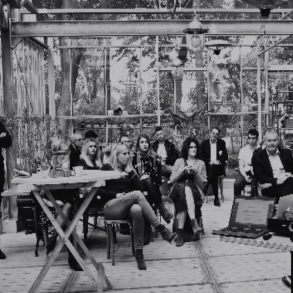By Lisa Gill and originally published as a single article at corporate-rebels.com
Part 1 of this article is here.
A focus on working climate
The second pillar we’ve found is critical to creating a flourishing self-managing team or organisation is a focus on working climate. Joycelyn Davis describes climate in her book The Art of Quiet Influence:
“Climate is people’s perceptions of the workplace, or what it feels like to work in a place. It is not the same as culture. Climate is malleable and can change quickly, while culture, which is the underlying values and unwritten rules of an organisation, is durable and slow to change.
“Climate has been shown to affect motivation, performance, and financial results and is, in turn, affected most strongly by managers’ daily actions rather than by anonymous forces such as organisational history, systems, and strategy. Everyone talks about company culture, but company climate is the more powerful tool for improving results.”
In most organisations, there is little to no focus on the working climate. Discussions about team performance tend to be limited to operational, “surface” issues – strategy, process, procedure, tasks and so on.
What most of us don’t dare to talk about are the taboo issues, the things beneath the surface. Yet these are so often precisely the things that get in the way for teams to be effective. If we can learn to talk about and shift our working climate, there is enormous energy and creativity to be unlocked.
Here are some tips for focusing on working climate:
- Learn to tell the weather – start paying attention to how the climate feels in your team meetings and try to put words to it. Example adjectives are: open, jokey, resigned, frosty, constructive, tense, trusting…
- Practice naming the climate – being able to name the climate helps to make it tangible to the group, and then you can do something about it. For example, “I notice the climate in our team today feels heavy. What’s the source of that, do you think?”
- A mindset shift from victims to co-producers – in a self-managing team, we all need to see ourselves as co-producers of our working climate. Each one of us is responsible for creating and maintaining the working climate we desire, which means establishing clear team agreements and having the courage to bring up issues or transform conflicts, rather than waiting for someone else to fix them.
A culture of mandate and involvement
As author Chuck Blakeman once told me, it doesn’t work in an organisation to “declare self-management and say: ‘I’ll be on the golf course’ – that’s abdication.” Making the paradigm shift to a more self-managed way of working takes time and practice. Creating and nurturing a culture of mandate and involvement is crucial.
When I say mandate, I’m referring to the given permission or the authority to do something. Again, this isn’t a one-off announcement, so here are two useful habits you can develop, especially as a leader. The first is “getting the mandate”, and the second is “giving the mandate away”.
Getting the mandate
Getting the mandate means asking for explicit consent before doing something. Choice is perhaps the defining feature of an adult-to-adult way of working and being together – it is only when we have the ability to say “no” to something that “yes” has any meaning.
With choice comes ownership and accountability. That’s why Spanish consultancy K2K Emocionando doesn’t go ahead with any transformation processes until the whole company (after visiting other companies and talking to employees who have gone through the process themselves) has voted, and at least 80% must say yes.
It is only when we have the ability to say “no” to something that “yes” has any meaning.click to tweet
At a micro level, a magical question you can use is: “Is it OK if…?” For example, “Is it OK if I give you some feedback?” In traditional companies, most managers vomit feedback on their employees without ever getting consent. It’s no wonder employees end up in a state of learned helplessness!
Another example would be in a meeting, saying something like: “I’d like us to do something differently in this meeting because I think it could help us generate a new way of thinking – would it be OK if I facilitate us through a process for twenty minutes and then we see if it was helpful or not?” When we do this, and get an authentic “yes”, it creates an adult-to-adult dynamic where both parties become co-responsible for the experience.
Giving away the mandate
Giving away the mandate is even more important. If you’re a leader, in any sense of the word, you’ll find that individuals and groups are very skilled at, often unconsciously, nudging the responsibility back to you. This is because we’ve been conditioned in schools and workplaces to defer decision-making and answers to someone “above us”.
To help us all unlearn this, we can all become skilled at giving away the mandate.
Some ways of doing this are:
- Be explicit in stating who has the mandate, for example: “The decision isn’t mine but the team’s – what do you think we should do?”
- Embrace silence – often we ask a question or wait for responses, and too quickly fill the silence because we worry “if I don’t fill it, no one will”. When you’re silent, someone will step in
- Instead of adding solutions and ideas, develop your listening muscle. Listen to what’s being said as well as what’s “under the surface” (what’s not being said, feelings, climate, what’s in the way) and summarise back to the team or individual – often people become activated just by being listened to and hearing back what you’ve picked up
- Ask coaching questions such as: “So what’s needed to move forward here?”, “What could be the next (or first) step?”, “How could you do [their words]?”
When people feel truly involved and accountable, all sorts of ideas, solutions, systems, and structures are created in service of the team, and the level of commitment to making them happen is next-level.
For more on this, check out the book Lisa Gill has recently published: ‘Moose Heads on the Table: Stories About Self-Managing Organisations from Sweden‘, co-authored with Karin Tenelius.
Check out the great comments on the original article.
Republished with permission.
Featured image and some paragraph spacing added by Enlivening Edge Magazine.




